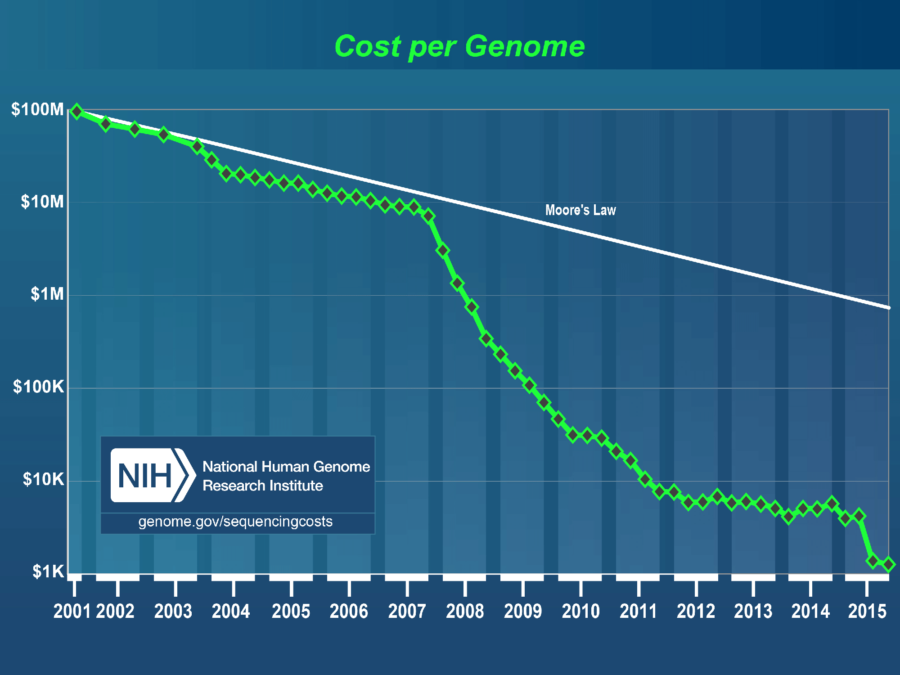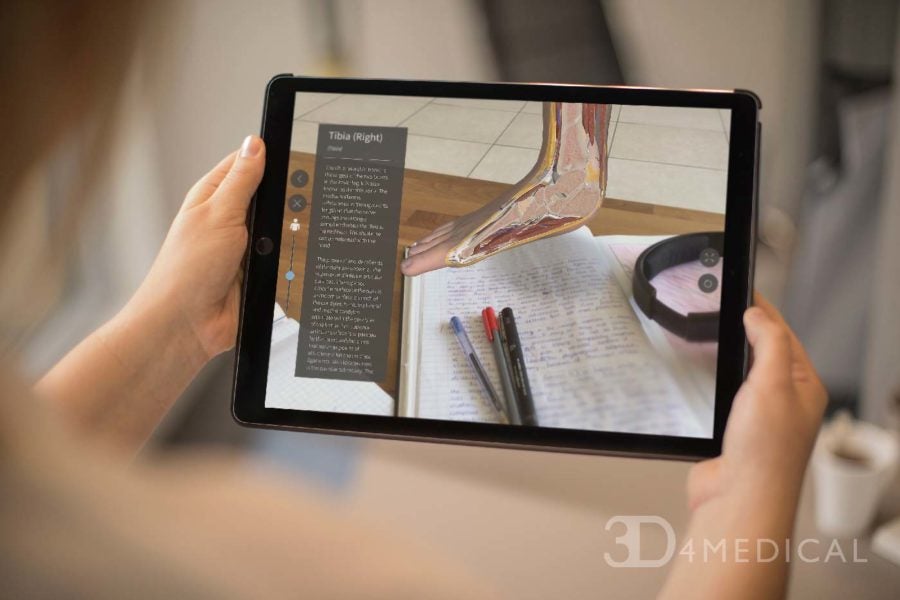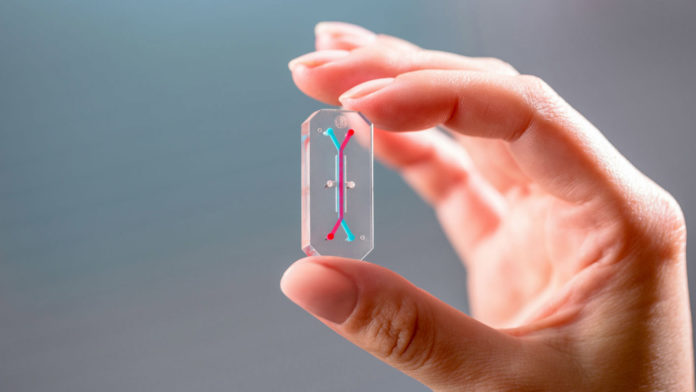We are on the brink of a revolution in healthcare. AI is making the drug discovery process >100X faster and cheaper, and 90 percent more likely to succeed in clinical trials. Mobile health is predicted to become a $102 billion market by 2022, putting a virtual doctor, on-demand, in your back pocket. And the cost of sequencing your genome (3.2 billion base pairs) has decreased 100,000-fold over 13 years, a staggering speed that is 3 times faster than the rate of Moore’s Law.

But humans have barely scratched the surface. As exponential technologies explode onto the scene all at once, we are about to witness the unprecedented rise of personalized, ubiquitous, and intelligent healthcare. In this blog, we’ll discuss how converging exponential technologies are enabling:
- Personalized medicine
- Delocalized (“everywhere”) care
- The new era of intelligent prevention
We are truly living in an era when anything is possible.
Personalized Medicine
Currently, research focuses on one-size-fits-all solutions. Clinical trials aim to discover therapies for the general population—and can only introduce them after years of expensive initial research, lab testing, human testing clearance, multiple phases of patient testing and maybe ultimate approval.
But what if all treatments were targeted at your individual genome, from lab testing to ready product, and at a lower cost? Using their powerful deep learning systems, NVIDIA aims to tailor treatments to an individual’s genomic makeup. Others, like a team at the University of Toronto, are building genetic interpretation engines to pinpoint cancer-causing genetic mutations in individual patients. Similarly, researchers at UNC’s Lineberger Comprehensive Cancer Center use cognitive computing to identify individually relevant therapeutic options based on one’s genetic profile.
But this is only the beginning. Take Harvard Wyss Institute’s organs-on-chips. Containing microfluidic channels with living human cells and mechanical mimicry of an organ’s microenvironment, the Wyss Institute’s organs-on-chips can serve as micro artificial hearts, lungs, intestines and kidneys, among many other organs.
The biotech company Emulate has raised millions for use of these organs-on-chips to replace traditional animal testing and deliver personalized medicine.

In the future, these could be your cells on a chip, tested with treatment after treatment until the right one sticks, tailored exactly to your genetic makeup. But it doesn’t stop at genetically personalized treatments. Welcome to personalized diets.
Each of us has about 40 trillion microorganisms that occupy our gut, and each microbiome —like our DNA—is distinct. Through a simple home kit, Viome applies machine learning to analyze your microbiome, then makes optimal, personalized nutritional recommendations for your gut.
Bowhead Health tackles yet another approach to personalized medicine. With either saliva or a blood-prick test, Bowhead’s small home device reads this biometric data in real time and transmits the reading to doctors. As soon as key deficiencies are identified, your in-home Bowhead device dispenses a customized, vitamin-based pill, all your own.
Delocalized Care
Kaiser Permanente’s chairman and chief executive George Halvorson foresees plummeting healthcare costs as care migrates farther from hospitals and doctors’ offices and into any and every setting via the internet. The harbingers of “everywhere care” are so abundant, they deserve a blog of their own. Here are the highlights:
(1) mHealth (or Mobile Health) has already grown beyond a $23 billion market, and by some estimates will surpass $102 billion by 2022. Step aside, WebMD.
AI-powered medical chatbots are flooding the market. Diagnostic apps can identify anything from a rash to diabetic retinopathy. And with the advent of global connectivity, mHealth platforms enable real-time health data collection, transmission and remote diagnosis by medical professionals.
Already available to residents across North London, Babylon Health offers immediate medical advice through AI-powered chatbots and video consultations with doctors via its app. Babylon now aims to build up its AI for advanced diagnostics and even prescription.
Others, like Woebot, take on mental health, using cognitive behavioral therapy in communications over Facebook Messenger with patients suffering from depression.
New diagnostics and screening apps are also beginning to empower the next generation of patient-doctors. In addition to phone apps and add-ons that test for fertility or autism, the now-FDA-approved Clarius L7 Linear Ultrasound Scanner can connect directly to iOS and Android devices and perform wireless ultrasounds at a moment’s notice.
With mHealth platforms like ClickMedix, which connects remotely-located patients to medical providers through real-time health data collection and transmission, what’s to stop us from delivering needed treatments through drone delivery or robotic telesurgery?
(2) AR/VR will revolutionize medical training, making it immersive and ubiquitously accessible.
It’s no wonder the healthcare industry suffers from a shortage of doctors. Medical training is not only expensive, but its conventional methods also severely limit scalability. With virtual and augmented reality, however, gone are the days of peering over a surgeon’s shoulder to learn from another’s experience.
Why not perform surgery on an annotated, virtual 3D body from anywhere in the world, for minimal cost, and do no harm? Companies like Echopixel and 3D4Medical are achieving this delocalization and hands-on training with remarkable style, translating 2D scans and anatomy into live AR and VR patients.

(3) AI-aided IoMT (Internet of Medical Things) may be one of the most exciting frontiers in healthcare.
Welcome to the age of intravenous nanomachines, electronic implants and pill-embedded sensors. While wearables have long been able to track and transmit our steps, heart rate and various other health factors, smart nanobots and ingestible sensors will soon be able to monitor countless health parameters and even help diagnose disease.
But it doesn’t stop there. As nanosensor and nanonetworking capabilities develop, these tiny bots may soon communicate with each other, enabling the targeted delivery of drugs and autonomous corrective action.
Some companies, however, are working on high-precision sensors that need not enter the body. Apple, for instance, is reportedly building sensors that can noninvasively monitor blood sugar levels in real-time for diabetic treatment.
In last year’s Qualcomm Tricorder XPRIZE, we were proud to grant $2.5 million in prize money to the winning team, Final Frontier Medical Devices. Using a group of noninvasive sensors that collect data on vital signs, body chemistry, and biological functions, Final Frontier integrates this data in their powerful, AI-based DxtER diagnostic engine for rapid, high-precision assessments. Their engine combines learning from clinical emergency medicine and data analysis from actual patients.
IoT-connected sensors are also entering the world of prescription drugs. Just this winter, the first sensor-embedded pill—Abilify MyCite—was approved by the FDA. Digital pills like Abilify will now be able to communicate medication data to a user-controlled app, to which doctors may be granted access for remote monitoring. But nanobots and IoT-connected sensors get a lot more exciting when they converge with 3D printers, AI supercomputers, and the power of big data.
Intelligent Prevention
Take a minute to imagine this unprecedented convergence: Nanobot sensors flowing through your bloodstream monitor different health parameters, measuring nutrient levels and keeping an eye on your cholesterol. As data flows in, these connected sensors transmit your health data in real time to a remote AI-powered supercomputer geared with all your genomics, microbiome, and medical history data—access secured via blockchain, of course.
As abnormalities are detected, this AI-driven doctor sifts through tomes of data to identify an optimal, personalized treatment based on your genetic profile and real-time health data. Once vetted and approved, a prescription arrives at the dashboard of your in-home medical 3D printer. With customized dosage, your 3D printer separates the drug’s active ingredients with micro-barriers and embeds a printed sensor to monitor variations in drug release and effectiveness. Feedback is instantaneously communicated through IoMT, and AI again improves its personalized medicine for future treatment.
You might think AI medical powerhouses and autonomous sensors leave human doctors out of luck. But many digital healthcare startups are in fact redefining and elevating the role of our doctors.
Take Forward, for example. A digitized doctor’s office geared with AI-driven diagnostics and personalized medicine, Forward is finding a way to liberate its doctors from many of the tedious necessities that so often constrain their ability to engage with patients.
As medical AI enterprises like Microsoft’s Healthcare NExT and IBM Watson Health bring incredible power to diagnostics, drug discovery, and genetic therapy development, doctors may be freed to take on consultative roles—educating patients, performing many more remote surgeries with the help of robotics, and aiding in preventive care.
Final Thoughts
Nowhere is convergence bringing greater breakthroughs than in healthcare.
As transformative technologies like CRISPR-Cas9 unlock our genetic potential, quantum computing massively ups the speed of AI-powered drug discovery, 3D printing places the power of preventive medicine in the hands of consumers, and next-generation implants enhance our minds, we are truly living in an era when anything is possible.
Join Me
(1) A360 Executive Mastermind: This is the sort of conversation I explore at my Executive Mastermind group called Abundance 360. The program is highly selective, for 360 abundance and exponentially minded CEOs (running $10M to $10B companies). If you’d like to be considered, apply here.
Share this with your friends, especially if they are interested in any of the areas outlined above.
(2) Abundance-Digital Online Community: I’ve also created a Digital/Online community of bold, abundance-minded entrepreneurs called Abundance-Digital.
Abundance-Digital is my ‘onramp’ for exponential entrepreneurs – those who want to get involved and play at a higher level. Click here to learn more.
Image Credit: Emulate Bio



